University of Wisconsin–Eau Claire
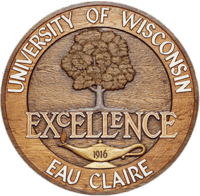 | |
| Motto | Excellence. Our measure, our motto, our goal. |
|---|---|
| Type | State university |
| Established | 1916 |
| Endowment | US $37,524,837[1] |
| Chancellor | James C. Schmidt[2] |
| Vice-Chancellor |
Beth Hellwig Patricia Kleine |
| Dean |
Joseph Abhold Diane Hoadley David Baker Gail P. Scukanec Marty Wood Linda Young [3] |
Academic staff | 479 |
Administrative staff | 1,150 |
| Students | 11,046 |
| Undergraduates | 10,499[4] |
| Postgraduates | 547[4] |
| Location |
Eau Claire, Wisconsin, United States 44°47′56″N 91°29′58″W / 44.798950°N 91.499346°WCoordinates: 44°47′56″N 91°29′58″W / 44.798950°N 91.499346°W |
| Campus | Urban, 333 acres (135 ha) |
| Colors |
Navy blue, Old gold[5] |
| Nickname | Blugolds |
| Website |
www |
 | |
The University of Wisconsin–Eau Claire (also known as UW–Eau Claire, UWEC or simply Eau Claire) is a public liberal arts university located in Eau Claire, Wisconsin, United States. Part of the University of Wisconsin System, it offers bachelor's and master's degrees and is categorized as a postbaccalaureate comprehensive institution in the Carnegie Classification of Institutions of Higher Education. UW-Eau Claire had an annual budget of approximately 230 million dollars in the 2015-15 academic year.[6]
The campus consists of 28 major buildings spanning 333 acres (135 ha). An additional 168 acres (68 ha) of forested land is used for environmental research.[7] UWEC is situated on the Chippewa River in the Chippewa Valley.[8][9]
The university is affiliated with the NCAA's Division III and the Wisconsin Intercollegiate Athletic Conference (WIAC).[10] The student body's mascot is Blu the Blugold.[11]
History
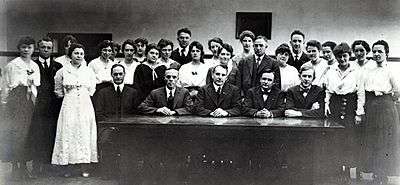
Founded in 1916 as the Eau Claire State Normal School, the university originally offered one-, two- and three-year teachers' courses and a principals' course. At the school's founding ceremony Governor Emanuel L. Philipp said the university was founded "in order that you, the sons and daughters of the commonwealth, might have better educational service." He went on to say the university would "go on benefiting the state of Wisconsin as long as the walls of this massive building (Schofield Hall) last."[12]
As a college primarily focused on educating teachers, Eau Claire housed Park Elementary, a laboratory school. Park Elementary had an unusual architectural design that included a hidden third story balcony used by professors and student teachers to observe classes.
As a result of the changing educational focus of the university, this method of teaching new teachers fell out of use and Park Elementary School was closed. Most of the building was repurposed for general university classroom use, with about a third of the space dedicated to a child daycare center. The building was demolished in 2012.
In 1927, the name of the college was changed to Eau Claire State Teachers College and the school began offering a bachelor's degree program. The campus was also altered to accommodate a 300-man detachment from the Army Air Corps.

Eau Claire's role as an educational institution underwent profound changes in the 1940s and 1950s. The university saw a significant rise in enrollment and widened its scope beyond educating future teachers. Eau Claire president W. R. Davies, speaking at a university assembly, said "the goal is a college of education that will rank as one of the best in the middlewest, with a wide enough offering to truly serve the needs of the college youth of northwest Wisconsin."[15] In 1951, the Wisconsin Board of Regents of the University of Wisconsin System authorized the school to offer bachelor of arts and science degrees in liberal arts; subsequently, the name of the school was changed to the Wisconsin State College at Eau Claire.
During the 1960s, the university saw further expansion. Science and art buildings were erected and several dormitories were built or expanded to meet the needs of an ever-growing student population. The university began to market itself more aggressively because of increased competition from surrounding campuses. Eau Claire's nickname - "Wisconsin's Most Beautiful Campus" - was first developed during this time. Highlighting the university's aesthetic appeal, an Eau Claire poet wrote, "Through and from a shady glen / A charming streamlet hies / And rippling along its picturesque way / A campus glorifies."[16] In 1964, the Board of Regents gave university standing to the state colleges, and the institution at Eau Claire was renamed Wisconsin State University – Eau Claire. The 1960s are remembered as a "flowering of excellence on the campus."[17]
In 1962, Martin Luther King, Jr. visited the campus and called on president John F. Kennedy to issue a second Emancipation Proclamation. King said "the first proclamation freed us from slavery - the second will free us from segregation, which is actually nothing more than slavery."[18]
During the late 1960s, the university was involved in several protests against the Vietnam War, including a 42-hour vigil and several marches. Though there were numerous protests, all of them remained peaceful. After the Kent State shootings, the university community planted four trees as a memorial to the dead students.[19] One protester, Eau Claire student John Laird, the son of U.S. Secretary of Defense Melvin R. Laird, made headlines when he announced his opposition to the war in Vietnam and his intention to join his fellow students in peaceful protest.[20]
In 1971, the name of the institution was changed to the University of Wisconsin – Eau Claire following the merger of the Wisconsin State University System and the University of Wisconsin System. In subsequent years, the university would solidify its tradition as a liberal arts campus. Currently, the university's stated mission is to provide "rigorous undergraduate liberal education" alongside "distinctive professional and graduate programs that build on and strengthen our proud tradition of liberal education."[21] Since the 1971 merger, Eau Claire has expanded its course offerings, added more faculty and students, and enlarged campus grounds. Eau Claire has also acquired hundreds of acres of forested land primarily used for environmental research and has recently acquired St. Bede's Monastery.[22]
Campus
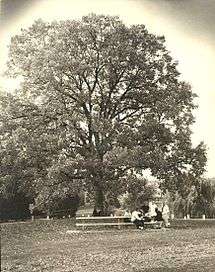
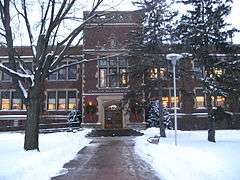
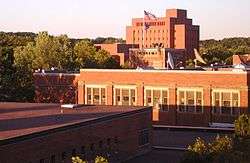
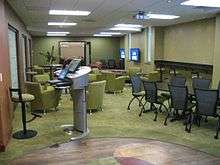
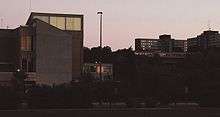
The University of Wisconsin–Eau Claire campus sits on the banks of the Chippewa River. The campus is located in an urban setting, close to Eau Claire's historic Water Street.
The main academic building on campus is Schofield Hall, home to administrative offices. The building was named after Harvey Schofield, the first president of the university. Other academic buildings include the Phillips Science Hall, the Hibbard Humanities Hall, the Haas Fine Arts Center, the Schneider Social Sciences Hall, and Centennial Hall.[23]
The Davies Center, a hub of the campus, is home to dining halls, a movie theatre, the offices for student newspapers and the student senate, coffee shops, the student bookstore, and spaces for study and socializing. The building was named after William R. Davies, a noted president of the University. In 2011, the old Davies Center was torn down. A new facility was completed in 2013.[24]
Sports facilities include the W. L. Zorn Arena, Hobbs Ice Center, Bollinger Fields and Carson Park.
Organization and administration
Since its founding in 1916, the University of Wisconsin–Eau Claire has had three presidents and six chancellors. One president, Leonard Haas, took an interim assignment with the UW System and returned as chancellor.[25]
- Harvey Schofield, President 1916–1940
- William R. Davies, President 1941–1959
- Leonard Haas, President 1959–1971, Chancellor 1973–1980
- M. Emily Hannah, Chancellor 1981–1984
- Larry G. Schnack, Chancellor 1985–1997
- Donald J. Mash, Chancellor 1998–2005
- Brian Levin-Stankevich, Chancellor 2006–2012
- James C. Schmidt, Chancellor 2013–present
Academic profile
Eau Claire is organized into four colleges: the College of Business, the College of Arts and Sciences, the College of Education and Human Sciences, and the College of Nursing. The school offers about 80 undergraduate concentrations and 14 graduate concentrations.[26] The university offers several master's degrees and one doctoral degree. Enrollment is approximately 11,000 undergraduate and 500 graduate students. Eau Claire's academic programs operate on a semester calendar.
The University of Wisconsin–Eau Claire has been accredited by the North Central Association of Colleges and Schools since 1950. Other agencies also fully accredit specific programs.[27]
Students are required to show competency in mathematics, English, a foreign language and foreign cultures. Courses that deal with issues relating to diversity are also required.[28] Students are also required to take a "service-learning" course where they engage in charitable work with the Eau Claire community. Service-learning "is intended to provide students with an opportunity to serve their community, apply knowledge gained in the classroom, enhance their critical thinking skills, and become informed, ethical, responsible, and active citizens."[29]
The Center of Excellence for Faculty and Undergraduate Student Research Collaboration was established at UW-Eau Claire to encourage students to incorporate "research into their undergraduate experience."[30] Students working with faculty publish papers in academic journals.[1] Eau Claire's faculty/student research program has been nationally recognized.[1]
Reputation and rankings
For 2016, U.S. News and World Report ranked UW-Eau Claire 33rd among regional universities in the Midwest out of 112 public and private colleges ranked.[1] U.S. News has ranked Eau Claire "among the top five regional public institutions in the Midwest, and in the top third of public and private Midwestern regional universities every year since 1995."[31]
UW-Eau Claire also placed in Money (magazine) Top 50 public university. [32] This study ranked public universities value in degrees. [33]
Kiplinger's Personal Finance has included Eau Claire in their list of the "100 Best Values in Public Education."[34] According to the publication, the "rankings are based on academic quality, overall costs and financial aid availability."[35][35][36]
The university is one of four undergraduate institutions in the United States to have four or more Dreyfus teacher scholars on the faculty and was among the 141 public and private colleges, universities and professional schools named in the President's Higher Education Community Service Honor Roll with Distinction for General Community Service.[1][37][38][39] The Templeton Foundation included the university in its list of colleges that "encourage character development."[40]
UW-Eau Claire sends more students abroad than any other master's level institution in Wisconsin, and it ranks 10th nationally among all master's schools in the number of students who study abroad.[41][42]
Special Collections and Archives
The Special Collections and Archives at the University of Wisconsin–Eau Claire houses the official and unofficial records of the university from its founding to the present. It also holds one of the nation's largest collections of jazz, which includes more than 1000 charts and 1000 recordings of artists such as Woody Herman, Sammy Nestico, Count Basie, Stan Kenton, Benny Goodman and Henry Mancini. Several of the charts and recordings are signed and unique.[43][44]
The UW-Eau Claire Archives is a member of the Area Research Center Network of the Wisconsin Historical Society, serving Buffalo, Chippewa, Clark, Eau Claire, Rusk and Taylor counties, and holds manuscripts and records pertaining to those counties.[45]
Student life
Athletics
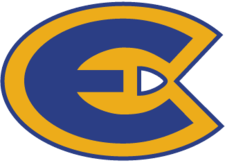
The university's athletic teams participate in the NCAA Division III sports program as well as the WIAC Intercollegiate Conference. There are nine men's varsity sports programs (basketball, cross country, football, golf, ice hockey, swimming and diving, tennis, track and field and wrestling) and eleven women's sports programs (basketball, cross country, golf, gymnastics, ice hockey, soccer, softball, swimming and diving, tennis, track and field, and volleyball). In terms of total wins, the Blugolds rank 14th in the entire NCAA Division III sports program.
.jpg)
The Blugolds have been national champions in cross country (1984, 2009, 2015), softball (2008), golf (2001), swimming (1983, 1987, 1988), ice hockey (1984, 2013) and indoor track and field (2015, 2016). Blugolds have been conference champions in men's swimming 25 of the past 40 years, conference champions in women's swimming 19 of the past 32 years, conference champions in women's tennis 10 of the last 18 seasons, conference champions in softball seven of the last 15 seasons, conference champions in women's golf seven of the last 13 seasons, conference champions in women's soccer three of the last six seasons, and conference champions in women's volleyball three of the last five seasons. The Blugolds hold nine national titles. They hold 140 conference titles and have won 36 Academic All-American Awards.[46] The Blugolds softball team appeared in one Women's College World Series in 1971.[47]
Team name and mascot
Eau Claire athletes are referred to as "Blugolds," a name coined to reflect the school colors, navy blue and old gold. Previous athletic team names include the Normals and the Normalites (because UWEC was founded as the Eau Claire State Normal School), the Blue and Gold Warriors, the Blue and Gold Gridirons, the Zornmen (in honor of Willis L. "Bill" Zorn, basketball and football coach from 1928–1968), the Golden Zornadoes, the Blue and Gold Squad, and the Blugold Squad.
The University of Wisconsin–Eau Claire has no official university mascot. However, in 2011, the student body voted in favor of a mythical bird as a mascot following a student-led initiative. The bird represents "the students of UW-Eau Claire, not the university itself."[48][49]
Marching band
The UW–Eau Claire Blugold Marching Band (BMB) is the largest D3 college marching band in the country. The BMB had 325 members in 2015.[50] The marching band has performed at high school marching band competitions and at two NFL halftime shows. The BMB has toured Europe twice, performing in France, Italy, and aboard a cruise ship in the Mediterranean. The band performed at the Bands of America Super Regional Championship in Indianapolis, Indiana, and will be completing its third European tour in Barcelona and Italy in January 2016.
Jazz
UW–Eau Claire's Jazz Ensemble I is a six-time winner of Down Beat's "Best College Big Band" award and has been nominated for a Grammy twice.[51] The New York Times has called the jazz program one of the most "well regarded in the country."[52] The university also hosts The Eau Claire Jazz Festival, one of the oldest, largest and most prestigious collegiate jazz festivals in the country.[53][54][55] The festival regularly attracts respected jazz musicians including Gary Burton, Bill Evans, Rufus Reid, Lewis Nash, Michael Brecker, Stanley Jordan, Eric Marienthal, Bobby Sanabria, Chris Potter, Benny Green, Charlie Byrd, Ira Sullivan and Slide Hampton.[56] The festival is composed of college bands, high school bands and invited performers. The college and high school bands compete to win awards, and UW-Eau Claire's Jazz I regularly performs with the invited guests. The festival also offers clinics, lectures and master classes with the invited performers. The Eau Claire Jazz Festival is currently 43 years old.[57]
Madrigal Dinner
The Madrigal Dinner is a 15th-century-style banquet. At the dinner, the Chamber Choir performs in costume as a royal court celebrating the harvest season and the holiday season. Traditionally, a student performs as a jester to add levity to the evening's festivities. Additionally, each year different students are chosen to play the roles of King and Queen. Guests attending the Madrigal Dinner often dress in period costumes, though no dress code is required. Beyond choral music, the Madrigal Dinner also incorporates modern Christmas music. Dishes such as wassail, beef vegetable soup and stuffed pork chops are served.[58]
The Forum
The Forum lecture series invites notable speakers to share their ideas with the Chippewa Valley community. The program was founded in 1942 by President W. R. Davies to express his vision of what the college might become as a cultural center. The Forum has hosted a variety of speakers including Martin Luther King, Jr., Carl Sagan, Henry Kissinger, William F. Buckley Jr., Maya Angelou, Richard Nixon and Noam Chomsky.[59]
Ann Devroy Memorial Forum
The Ann Devroy Memorial Forum is a partnership between The Washington Post and the University of Wisconsin–Eau Claire. The program was set up after the death of Ann Devroy, the chief White House correspondent at The Washington Post and a 1970 UW-Eau Claire graduate. Each year a noted journalist presents a keynote address at the Ann Devroy Memorial Forum, and a fellowship is given to a promising UW-Eau Claire journalism student.[60]
Viennese Ball
The annual Viennese Ball is a 40-year tradition at the University of Wisconsin–Eau Claire. A formal event, the ball "recalls the culture, history and music of 19th-century Vienna."[61] It is modeled on the New Year's Eve Kaiser Ball and showcases the University Symphony Orchestra, which performs waltzes and polkas from the Strauss Era, and the Eau Claire Jazz Ensemble I, which plays music from the Big Band Era. Other music is performed by smaller student and faculty ensembles. The ball also offers Austrian and American cuisine.[62] Proceeds have provided more than $1.5 million in music, service and international study awards for UW-Eau Claire students.[63]
Controversies
- The university was the center of a debate on academic freedom after officials denied a resident assistant the right to direct a Bible study in his dormitory. Officials said that it was inappropriate for a dormitory leader to have a Bible study because it might make non-Christian students uncomfortable. The student then sued the university and was eventually successful in ending the policy. This debate was widely publicized in part because the Foundation for Individual Rights in Education was deeply involved in the case.[64][65]
- The university was involved in a gay rights controversy when Tom Hilton, an information systems professor, negatively responded to a student email asking for his support for the Eau Queer Film Festival. Hilton called homosexuals the "walking wounded" and said that they needed to be helped to recover. The email ignited a "furor" at the school when it was leaked. Eventually, Hilton apologized for sending the message. Administrative action was taken, but Hilton was not fired.[66][67]
- UW–Eau Claire was the center of a controversy related to an oak tree sacred to Native Americans. The tree, officially known as the Council Oak, was the symbol of the UW–Eau Claire campus (found on the university's seal) and the meeting place for many Native American tribes negotiating truces. Although the original Council Oak had died years earlier, a second tree was planted at the site of the original "Council Oak." The plan to build a new student center put this oak tree in danger and many Native American groups in conjunction with some students protested the new plan, while others supported building the new center despite the risk to the tree. Eventually, after much publicity, it was decided to scrap the old plans, despite the large added expense, and build the 48.8 million dollar building at another location.[68][69]
Notable people
The University of Wisconsin–Eau Claire has more than 78,000 living alumni.[70]
See also
References
- 1 2 3 4 5 US News and World Report. "University of Wisconsin--Eau Claire". Retrieved June 8, 2016.
- ↑
- ↑ "Chancellor's Cabinet, Office of the Chancellor, University of Wisconsin-Eau Claire". Uwec.edu. Retrieved 8 June 2016.
- 1 2 About Us | University of Wisconsin-Eau Claire. Uwec.edu (2010-07-08). Retrieved on 2011-01-26.
- ↑ "The Power of AND" (PDF). Cdn.uwec.edu. Retrieved 2016-06-08.
- ↑ University of Wisconsin System. 2015-2016 Redbook, Volume 1: Budget Summaries. p. 347.
- ↑ Edwards, Keith (2011-07-15). "Land donation helps UWEC grow - WQOW TV: Eau Claire, WI NEWS18 News, Weather, and Sports". Wqow.com. Retrieved 2011-12-01.
- ↑ University of Wisconsin – Eau Claire. College Portraits. Retrieved 2011-01-26.
- ↑ "Education in the Eau Claire Area". Eauclaire-wi.com. Retrieved 8 June 2016.
- ↑ "University of Wisconsin-Eau Claire Athletics". Bluegolds.com. Retrieved 8 June 2016.
- ↑ Blu's Web Page. Uwec.edu. Retrieved on 2011-01-26.
- ↑ Hilda R. Carter; John R. Jenswold. ""That you, the sons and daughters of the commonowealth, might have better educational service"". The University of Wisconsin-Eau Claire: A History, 1916-1976. p. 1.
- ↑ Eleanor Roosevelt. "My Day, April 26, 1954.
- ↑ Hilda R. Carter; John R. Jenswold. "Wisconsin State College at Eau Claire: Both Liberal Arts and Specialization". The University of Wisconsin-Eau Claire: A History, 1916-1976. p. 77.
- ↑ Hilda R. Carter; John R. Jenswold. "Wisconsin State College at Eau Claire: Both Liberal Arts and Specialization". The University of Wisconsin-Eau Claire: A History, 1916-1976. p. 65.
- ↑ Hilda R. Carter; John R. Jenswold. "The Higher Learning". The University of Wisconsin-Eau Claire: A History, 1916-1976. p. 88.
- ↑ Hilda R. Carter; John R. Jenswold. "The Higher Learning". The University of Wisconsin-Eau Claire: A History, 1916-1976. p. 90.
- ↑ Hilda R. Carter; John R. Jenswold. "The Higher Learning". The University of Wisconsin-Eau Claire: A History, 1916-1976. p. 91.
- ↑ "Archived copy". Archived from the original on January 20, 2005. Retrieved January 16, 2012.
- ↑ Hilda R. Carter; John R. Jenswold. "The Era of the Student". The University of Wisconsin-Eau Claire: A History, 1916-1976. p. 106.
- ↑ "Mission Statement of the University, Academic Affairs". Uwec.edu. Retrieved 8 June 2016.
- ↑ "Saint Benedict's Monastery :: Saint Bede Monastery". Sbm.osb.org. Retrieved 8 June 2016.
- ↑ "Maps + Directions". Uwec.edu. Retrieved 8 June 2016.
- ↑ "Davies Center, Facilities, University Centers, UW-Eau Claire". Uwec.edu. Retrieved 8 June 2016.
- ↑
- ↑ "Majors + Minors". Uwec.edu. Retrieved 8 June 2016.
- ↑
- ↑ "2011-2012 Undergraduate Catalog" (PDF). Uwec.edu. Retrieved 8 June 2016.
- ↑ "Service-Learning". Uwec.edu. Retrieved 8 June 2016.
- ↑ "Center of Excellence, ORSP, UW-Eau Claire". Uwec.edu. Retrieved 8 June 2016.
- ↑ Karen Herzog (September 12, 2012). "Wisconsin schools again do well in U.S. News college rankings". Milwaukee Journal Sentinel. Retrieved June 8, 2016.
- ↑ http://new.money.com/money/best-colleges/rankings/best-public-colleges/
- ↑ <https://www.uwec.edu/news/news/uw-eau-claire-among-top-public-universities-on-money-s-best-colleges-list-1510>
- ↑ "Kiplinger\'s Best College Values". Kiplinger.com. Retrieved 8 June 2016.
- 1 2
- ↑ "How We Rank the Top Public : College Values". Kiplinger.com. Retrieved 8 June 2016.
- ↑ UW-Eau Claire University Bulletin. Uwec.edu. Retrieved on 2011-01-26.
- ↑ "University of Wisconsin - Eau Claire College Portrait". Collegeportraits.org. Retrieved 8 June 2016.
- ↑
- ↑ Foundation, John Templeton (1 January 1999). "Colleges that Encourage Character Development: A Resource for Parents, Students and Educators". Templeton Foundation Press. Retrieved 8 June 2016 – via Google Books.
- ↑
- ↑ "Open Doors - Institute of International Education". Iie.org. Retrieved 8 June 2016.
- ↑
- ↑ Everett, Courtney. "UW-Eau Claire houses nation's largest jazz collection". Weau.com. Retrieved 8 June 2016.
- ↑ "Special Collections and Archives McIntyre Library UW-Eau Claire". Uwec.edu. Retrieved 8 June 2016.
- ↑ "Quick Facts - University of Wisconsin-Eau Claire Athletics". Bluegolds.com. Retrieved 8 June 2016.
- ↑ Plummer, William; Floyd, Larry C. (2013). A Series Of Their Own: History Of The Women's College World Series. Oklahoma City, Oklahoma, United States: Turnkey Communications Inc. ISBN 978-0-9893007-0-4.
- ↑ "UW-Eau Claire student body selects mascot". Weau.com. Retrieved 8 June 2016.
- ↑ "Archived copy". Archived from the original on March 3, 2012. Retrieved August 27, 2012.
- ↑ "Untitled". Bluegoldmarchingband.com. Retrieved 8 June 2016.
- ↑ "Jazz Studies". Uwec.edu. Retrieved 8 June 2016.
- ↑ Caramanica, Jon (2011-06-03). "Who, What and Where is Bon Iver?". The New York Times.
- ↑ UW-Eau Claire Jazz Festival. Uwec.edu. Retrieved on 2011-01-26.
- ↑ Playing with the big boys – Gustavus jazz ensemble displays its chops – Posted on April 27th, 2010 by Al Behrends. Finearts.blog.gustavus.edu (2010-04-27). Retrieved on 2011-01-26.
- ↑ "Archived copy". Archived from the original on June 20, 2013. Retrieved March 6, 2012.
- ↑ Eau Claire Jazz Festival – Past Guest Artists – Jazz Musicians, Artists, Bands. Eauclairejazz.com. Retrieved on 2011-01-26.
- ↑ Eau Claire Jazz Festival – April 7–10, 2011 – Live Music & Art in the Chippewa Valley. Eauclairejazz.com. Retrieved on 2011-01-26.
- ↑
- ↑ "The Forum Tradition". Activities, Involvement and Leadership office, University Centers, University of Wisconsin-Eau Claire. Retrieved 2013-12-26.
- ↑ "History of the Forum". Communication and Journalism department, University of Wisconsin-Eau Claire. Retrieved 2013-12-26.
- ↑ "Viennese Ball, University Centers, UW-Eau Claire". Uwec.org. Retrieved 8 June 2016.
- ↑ "Tickets for UW-Eau Claire's Viennese Ball to go on sale February 5th". Wqow.com. Retrieved 8 June 2016.
- ↑ "Awards and Scholarships, Viennese Ball". University Centers, University of Wisconsin-Eau Claire. Retrieved 2014-07-26.
- ↑ University of Wisconsin-Eau Claire Suspends Bible Study Ban. Archive.newsmax.com (2005-12-01). Retrieved on 2011-01-26.
- ↑ "UW-Eau Claire suspends Bible study ban - FIRE". Thefire.org. 30 November 2005. Retrieved 8 June 2016.
- ↑ Finnegan, Leah (2010-10-14). "Professor's Anti-Gay E-mail Lands Him In Hot Water". Huffington Post.
- ↑ Amy Hetzner (October 14, 2010). "UW-Eau Claire administrator in trouble for e-mail". Milwaukee Journal Sentinel. Retrieved June 8, 2016.
- ↑ Campus tree leaves project in limbo « The Daily Reporter. Dailyreporter.com (2009-09-24). Retrieved on 2011-01-26.
- ↑
- ↑ "About the UW-Eau Claire Alumni Association". Uwec.edu. Retrieved 8 June 2016.